1993 CHEVROLET LUMINA tires
[x] Cancel search: tiresPage 150 of 324
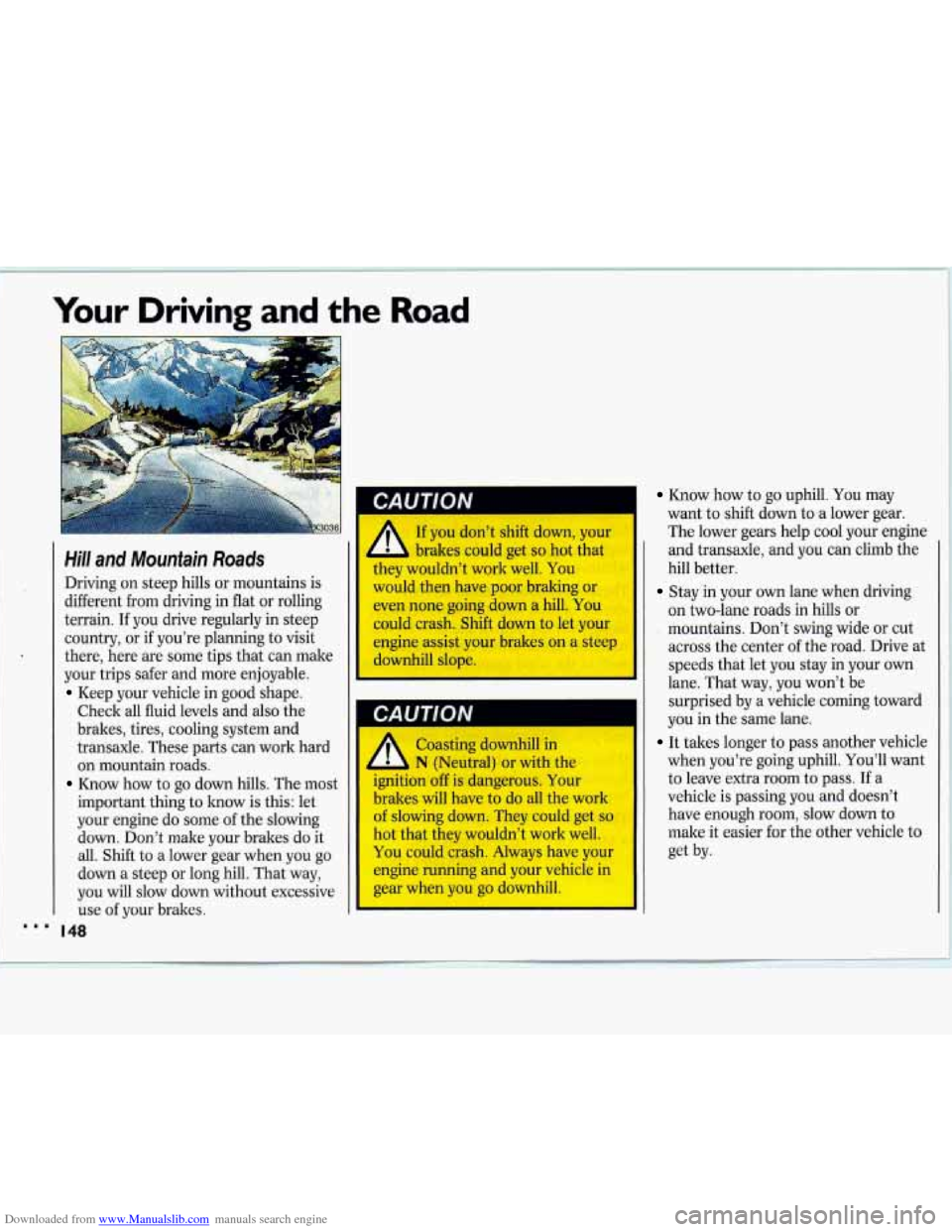
Downloaded from www.Manualslib.com manuals search engine Your Driving and the Road
CAUTION
Hill and Mountain Roads
Driving on steep hills or mountains is
different
from driving in flat or rolling
terrain. If you drive regularly in steep
country, or if you’re planning to visit
there, here are some tips that can make
your trips safer and more enjoyable.
Keep your vehicle in good shape.
Check all fluid levels and also the
brakes, tires, cooling system and
transaxle. These parts can work hard
on mountain roads.
Know how to go down hills. The most
important thing to know is this: let
your engine do some of the slowing
down. Don’t make your brakes do it
all. Shift to a lower gear when you go
down a steep or long hill. That way,
you will slow down without excessive
use of your brakes.
I48
A
If you don’t shift down, your
brakes could get
so hot that
they wouldn’t work well.
You
would then have poor braking or even none going down a hill. You could crash. Shift down to let your
engine assist your brakes on a steep
I downhill slope.
Know how to go uphill. You may
want to shift down to a lower gear.
The lower gears help
cool your engine
and transaxle, and you can climb the
hill better.
Stay in your own lane when driving
on two-lane roads in hills or
mountains. Don’t swing wide or cut
across the center of the road. Drive
at
speeds that let you stay in your own
lane. That way, you won’t be surprised by a vehicle coming toward
you in the same lane.
Coasting downhill in
11 It takes longer to pass another vehicle
N (Neutral) or with the when you’re going uphill. You’ll want
ignition off is dangerous. Your to leave extra room to pass.
If a
brakes will have to do all the work vehicle is passing you and doesn’t
of slowing down. They could get so have enough room, slow down to
hot that they wouldn’t work well. make it easier for the other vehicle to
You could crash. Always have your get by.
engine running and your vehicle in
gear when you go downhill.
i
Page 151 of 324
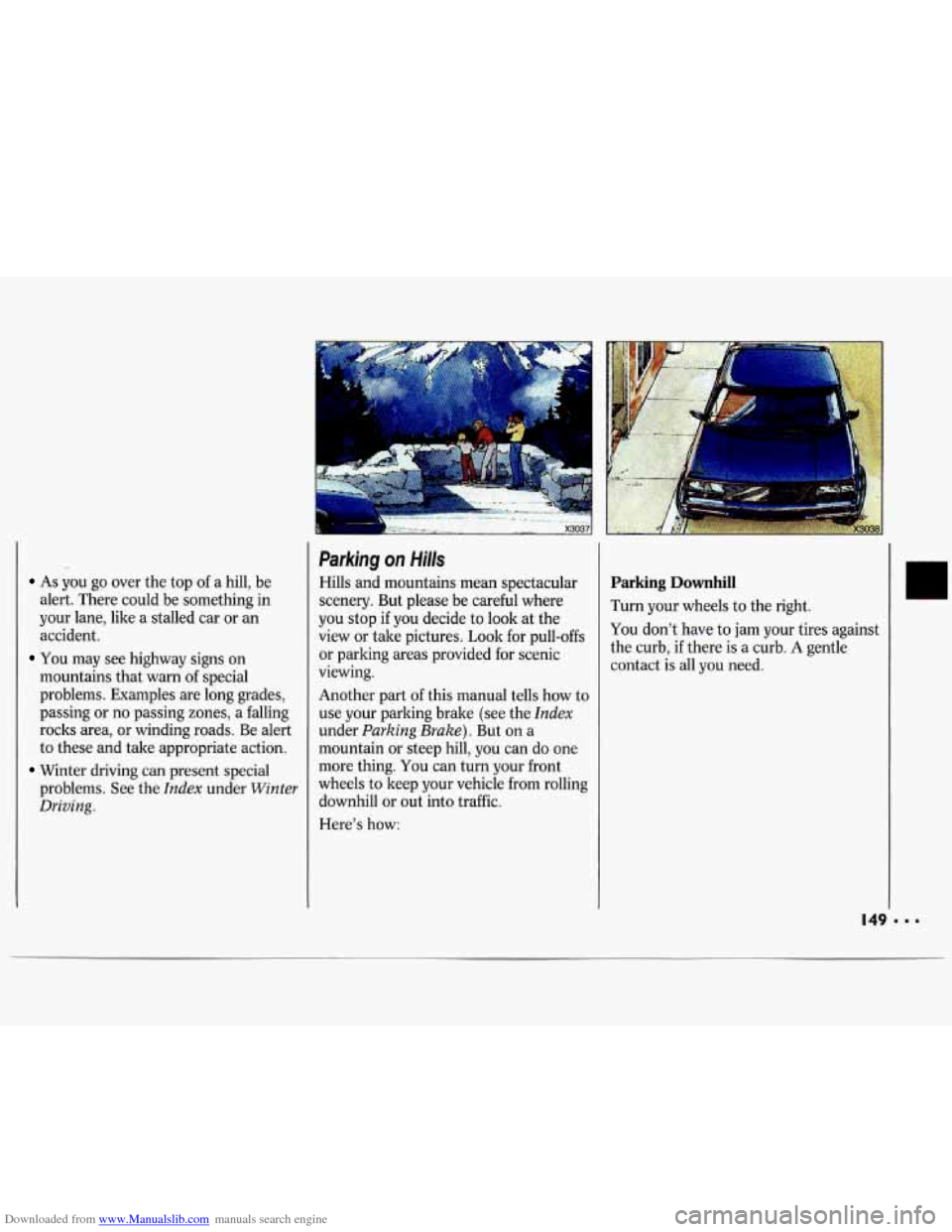
Downloaded from www.Manualslib.com manuals search engine As you go over the top of a hill, be
alert. There could be something in
your lane, like a stalled car or an
accident.
You may see highway signs on
mountains that warn
of special
problems. Examples are long grades,
passing or no passing zones, a falling
rocks area,
or winding roads. Be alert
to these and take appropriate action.
problems. See the
Index under Winter
Driving.
. ..
Winter driving can present special
,, “$“
Parking on Hills
Hills and mountains mean spectacular
scenery. But please be careful where
you stop if you decide to look at the
view or take pictures.
Look for pull-offs
or parking areas provided for scenic
viewing.
Another part
of this manual tells how to
use your parking brake (see the
Index
under Parking Brake). But on a
mountain or steep hill, you can do one
more thing. You can turn your front
wheels to keep your vehicle from rolling
downhill or out into traffic.
Here’s how:
Parking Downhill
Turn your wheels to the right.
You don’t have to jam your tires against
the curb, if there is a curb.
A gentle
contact is all you need.
Page 153 of 324

Downloaded from www.Manualslib.com manuals search engine Torque Lock
If you are parking on a hill and you
don’t shift your transaxle into
P (Park)
properly, the weight of the vehicle may
put too much force on the parking pawl
in the transaxle. You may find it
difficult
to pull the shift lever out of
P (Park). This is called “torque lock.”
To prevent torque lock, always be sure
to shift into
P (Park) properly before
you leave the driver’s seat. To find out
how, see the
Index under Shifting Into
P (Park).
When you are ready to drive, move the
shift lever out of
P (Park) before you
release the parking brake.
If torque lock does occur, you may need
to have another vehicle push yours a
little uphill to take some
of the pressure
from the transaxle, so you can pull the
shift lever out of
P (Park).
Winter Driving
Here are some tips for winter driving:
Have your Chevrolet in good shape
for winter. Be sure your engine
coolant mix
is correct.
Snow tires can help in loose snow,
but they may give you less traction on
ice than regular tires.
If you do not
expect to be driving in deep snow, but
may have to travel over ice, you may
not want to switch to snow tires at all.
You may want to put winter
emergency supplies in your trunk.
Include an ice scraper, a small brush
or broom, a supply of windshield
washer fluid, a rag, some winter outer
clothing, a small shovel, a flashlight,
a
red cloth, and a couple of reflective
warning triangles. And, if you will
be
driving under severe conditions,
include a small bag of sand, a piece
of
old carpet or a couple of burlap bags
to help provide traction. Be sure you
properly secure these items in your
vehicle.
151
Page 154 of 324
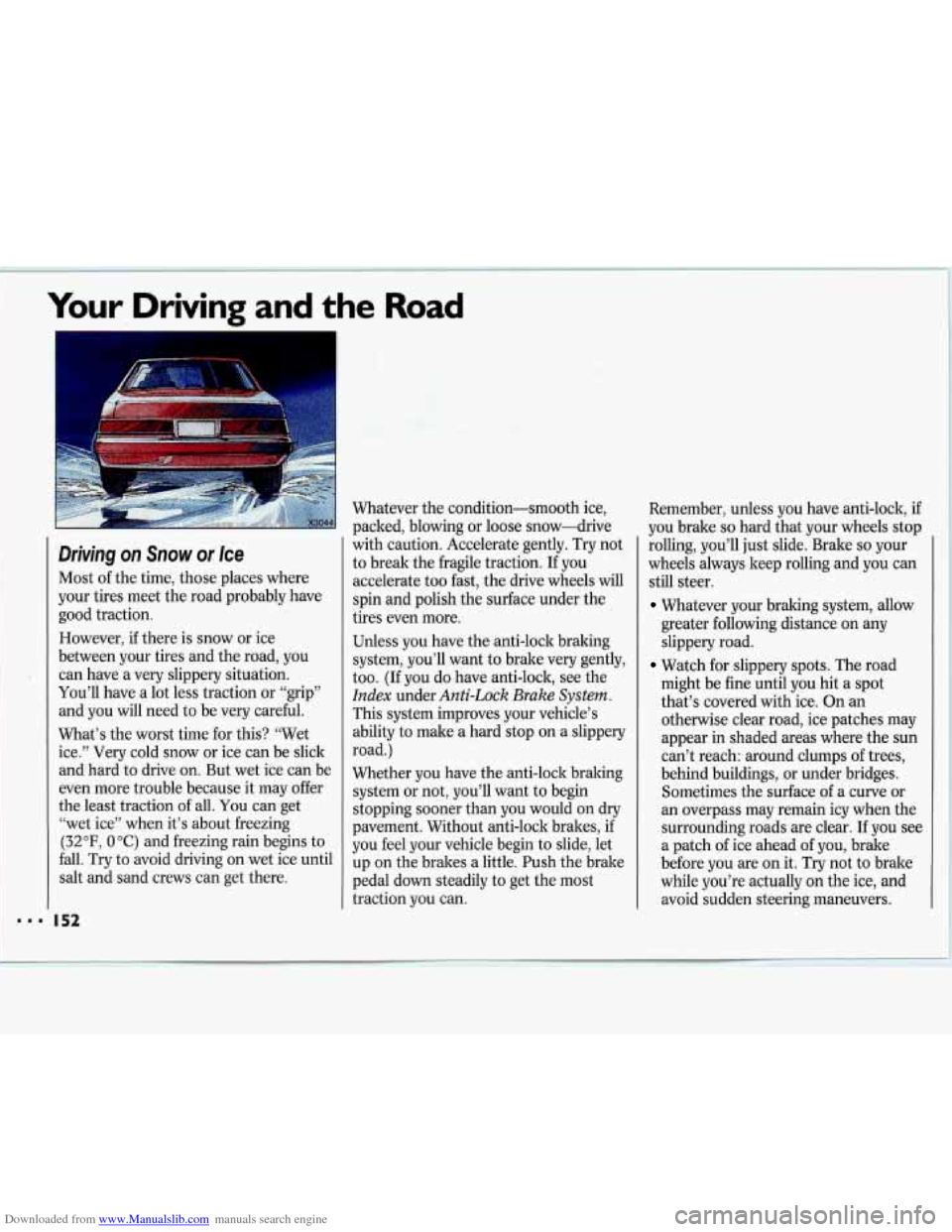
Downloaded from www.Manualslib.com manuals search engine Your Driving and the Road
Driving on Snow or Ice
Most of the time, those places where
your tires meet the road probably have
good traction.
However, if there is snow or ice
between your tires and the road, you
can have a very slippery situation.
You’ll have a lot less traction or “grip”
and you will need to be very careful.
What’s the worst time for this? “Wet
ice.” Very cold snow or ice can be slick
and hard to drive on. But wet ice can be
even more trouble because it may offer
the least traction of all. You can get
“wet ice” when it’s about freezing
(32°F’ 0 “C) and freezing rain begins to
fall. Try to avoid driving on wet ice until
salt and sand crews can get there. Whatever
the condition-smooth ice,
packed, blowing or loose snow-drive
with caution. Accelerate gently. Try not
to break the fragile traction. If you
accelerate too fast, the drive wheels will
spin and polish the surface under the
tires even more.
Unless you have the anti-lock braking
system, you’ll want to brake very gently,
too. (If you do have anti-lock, see the
Index under Anti-Lock Brake System.
This system improves your vehicle’s
ability to make a hard stop on a slippery
road.)
Whether you have the anti-lock braking
system or not, you’ll want to begin
stopping sooner than you would on dry
pavement. Without anti-lock brakes,
if
you feel your vehicle begin to slide, let
up on the brakes a little. Push the brake
pedal down steadily to get the most
traction you can. Remember, unless you have anti-lock,
if
you brake
so hard that your wheels stop
rolling, you’ll just slide. Brake
so your
wheels always keep rolling and you can
still steer.
Whatever your braking system, allow greater following distance on any
slippery road.
Watch for slippery spots. The road
might be fine until you hit a spot
that’s covered with ice. On an
otherwise clear road, ice patches may
appear in shaded areas where the sun
can’t reach: around clumps
of trees,
behind buildings, or under bridges.
Sometimes the surface of
a curve or
an overpass may remain icy when the
surrounding roads are clear. If you see
a patch of ice ahead of you, brake
before you are on it. Try not to brake
while you’re actually on the ice, and
avoid sudden steering maneuvers.
Page 157 of 324
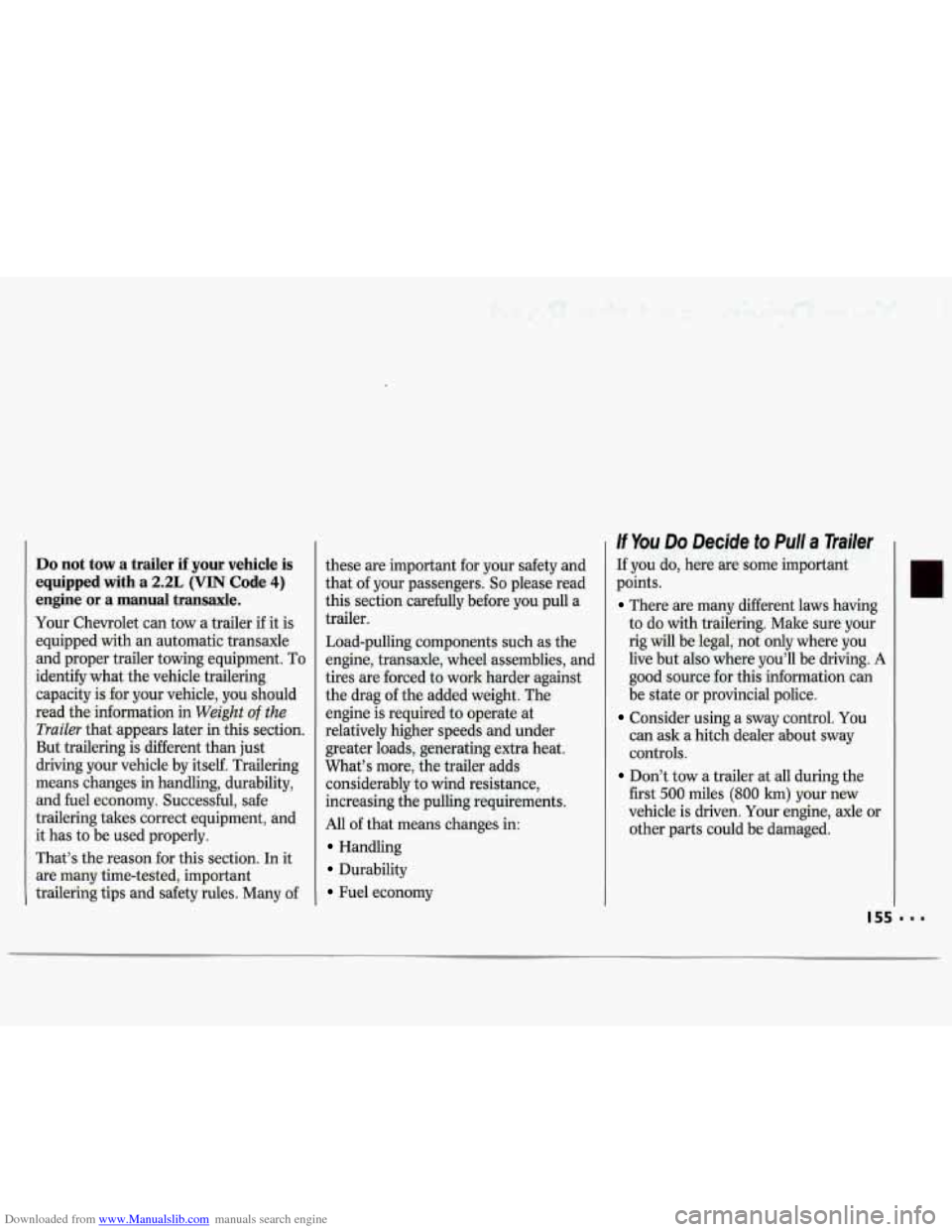
Downloaded from www.Manualslib.com manuals search engine Do not tow a trailer if your vehicle is
equipped with a 2.2L (VIN Code 4)
engine or a manual transaxle.
Your Chevrolet can tow a trailer if it is
equipped with an automatic transaxle
and proper trailer towing equipment. To
identify what the vehicle trailering
capacity is for your vehicle, you should
read the information in
Weight of the
Trailer
that appears later in this section.
But trailering is different than just
driving your vehicle by itself. Trailering
means changes
in handling, durability,
and fuel economy. Successful, safe
trailering takes correct equipment, and
it has to be used properly.
That’s the reason for this section. In it
are many time-tested, important
trailering tips and safety rules. Many of these are important
for your safety and
that of your passengers.
So please read
this section carefully before you pull a
trailer.
Load-pulling components such as the
engine, transaxle, wheel assemblies, and
tires are forced to work harder against
the drag of the added weight. The
engine is required to operate at
relatively higher speeds and under
greater loads, generating extra heat.
What’s more, the trailer adds
considerably to wind resistance,
increasing the pulling requirements.
All of that means changes in:
Handling
Durability
Fuel economy
If You Do Decide to Pull a Trailer
If you do, here are some important
points.
There are many different laws having
to do with trailering. Make sure your
rig will be legal, not only where you
live but also where you’ll be driving.
A
good source for this information can
be state or provincial police.
Consider using a sway control. You
can ask a hitch dealer about sway
controls.
Don’t tow a trailer at all during the
first
500 miles (800 lun) your new
vehicle is driven. Your engine, axle or
other parts could be damaged.
Page 159 of 324
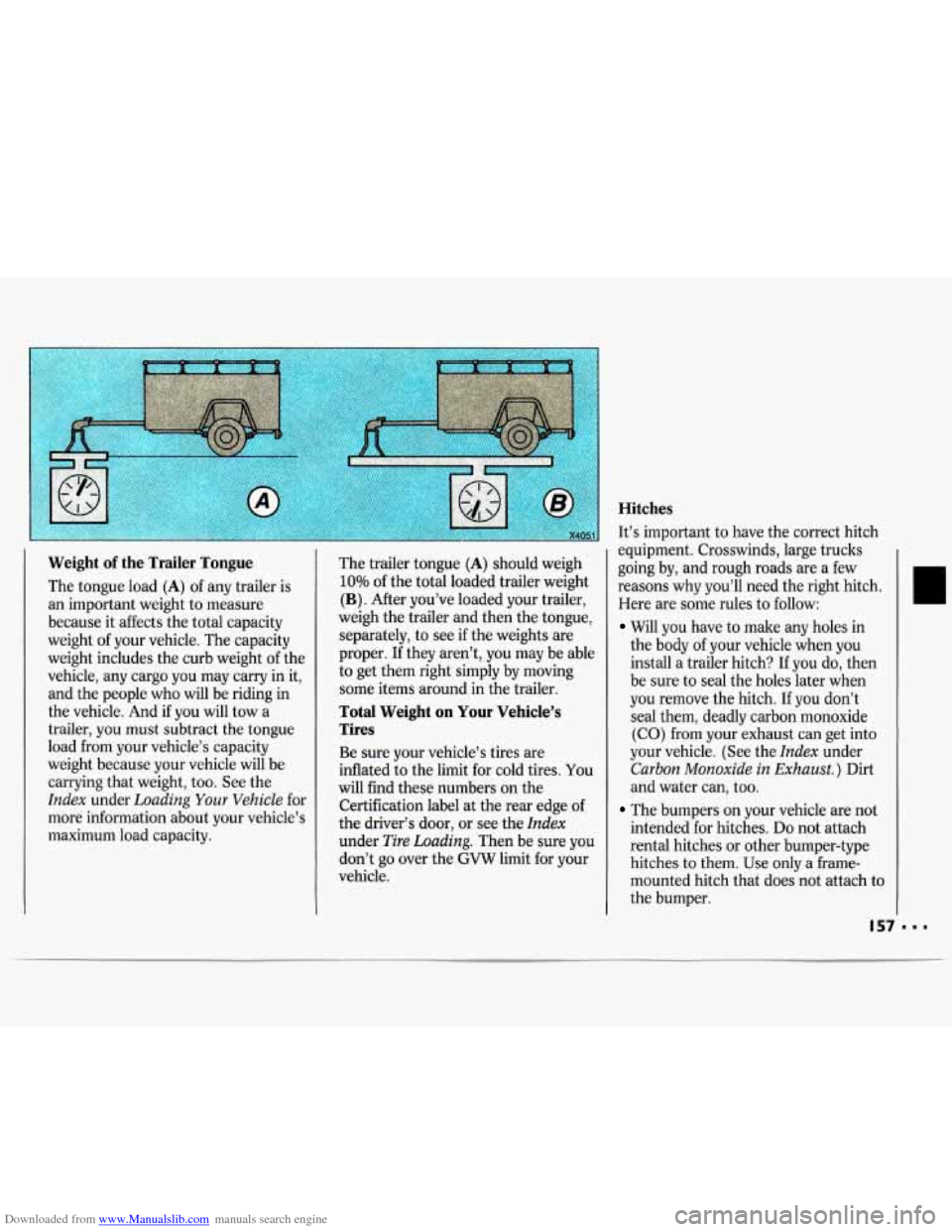
Downloaded from www.Manualslib.com manuals search engine Weight of the Trailer Tongue
The tongue load (A) of any trailer is
an important weight to measure
because it affects the total capacity
weight
of your vehicle. The capacity
weight includes the curb weight
of the
vehicle, any cargo you
may carry in it,
and the people who will be riding in
the vehicle. And
if you will tow a
trailer, you must subtract the tongue
load from your vehicle’s capacity
weight because your vehicle will be
carrying that weight, too. See the
Index under Loading Your Vehicle for
more information about your vehicle’s
maximum load capacity. The trailer tongue
(A) should
weigh
10% of the total loaded trailer weight
(B) . After you’ve loaded your trailer,
weigh the trailer and then the tongue,
separately, to see if the weights are
proper. If they aren’t, you may be able
to get them right simply by moving
some items around in the trailer.
Total Weight on Your Vehicle’s
Tires
Be sure your vehicle’s tires are
inflated to the limit for cold tires.
You
will find these numbers on the
Certification label at the rear edge of
the driver’s door, or see the
Index
under Tire Loading. Then be sure you
don’t
go over the GVW limit for your
vehicle.
Hitches
It’s important to have the correct hitch
equipment. Crosswinds, large trucks
going by, and rough roads are a few
reasons why you’ll need the right hitch.
Here are some rules to follow:
Will you have to make any holes in
the body
of your vehicle when you
install
a trailer hitch? If you do, then
be sure to seal the holes later when
you remove the hitch. If
you don’t
seal them, deadly carbon monoxide
(CO) from your exhaust can get into
your vehicle. (See the
Index under
Carbon Monoxide in Exhaust.) Dirt
and water can, too.
The bumpers on your vehicle are not
intended for hitches.
Do not attach
rental hitches or other bumper-type
hitches to them. Use only a frame-
mounted hitch that does not attach
to
the bumper.
Page 161 of 324

Downloaded from www.Manualslib.com manuals search engine Driving with a Trailer
Towing a trailer requires a certain
amount of experience. Before setting out for the open road, you’ll want to get
to know your rig. Acquaint yourself
with the feel of handling and braking
with the added weight of the trailer.
And always keep in mind that the
vehicle you are driving is now
a good
deal longer and not nearly
so responsive
as your vehicle is by itself.
Before you start, check the trailer hitch
and platform, safety chains, electrical connector, lights, tires and mirror
adjustment. If the trailer has electric
brakes, start your vehicle and trailer
moving and then apply the trailer brake
controller by hand to be sure the brakes
are worling. This lets you check your
electrical connection at the same time. During your
trip, check occasionally to
be sure that the load is secure, and that
the lights and any trailer brakes are still
working.
Following Distance
Stay at least twice as far behind the
vehicle ahead
as you would when
driving your vehicle without a trailer.
This can help you avoid situations that
require heavy braking and sudden
turns.
Passing
You’ll need more passing distance up
ahead when you’re towing a trailer.
And, because you’re a good deal longer,
you’ll need to go much farther beyond
the passed vehicle before you can return
to your lane.
Backing Up
Hold the bottom of the steering wheel
with one hand. Then, to move the
trailer to the left, just move that hand
to
the left. To move the trailer to the right,
move your hand to the right. Always
back up slowly and, if possible, have
someone guide you.
Page 171 of 324
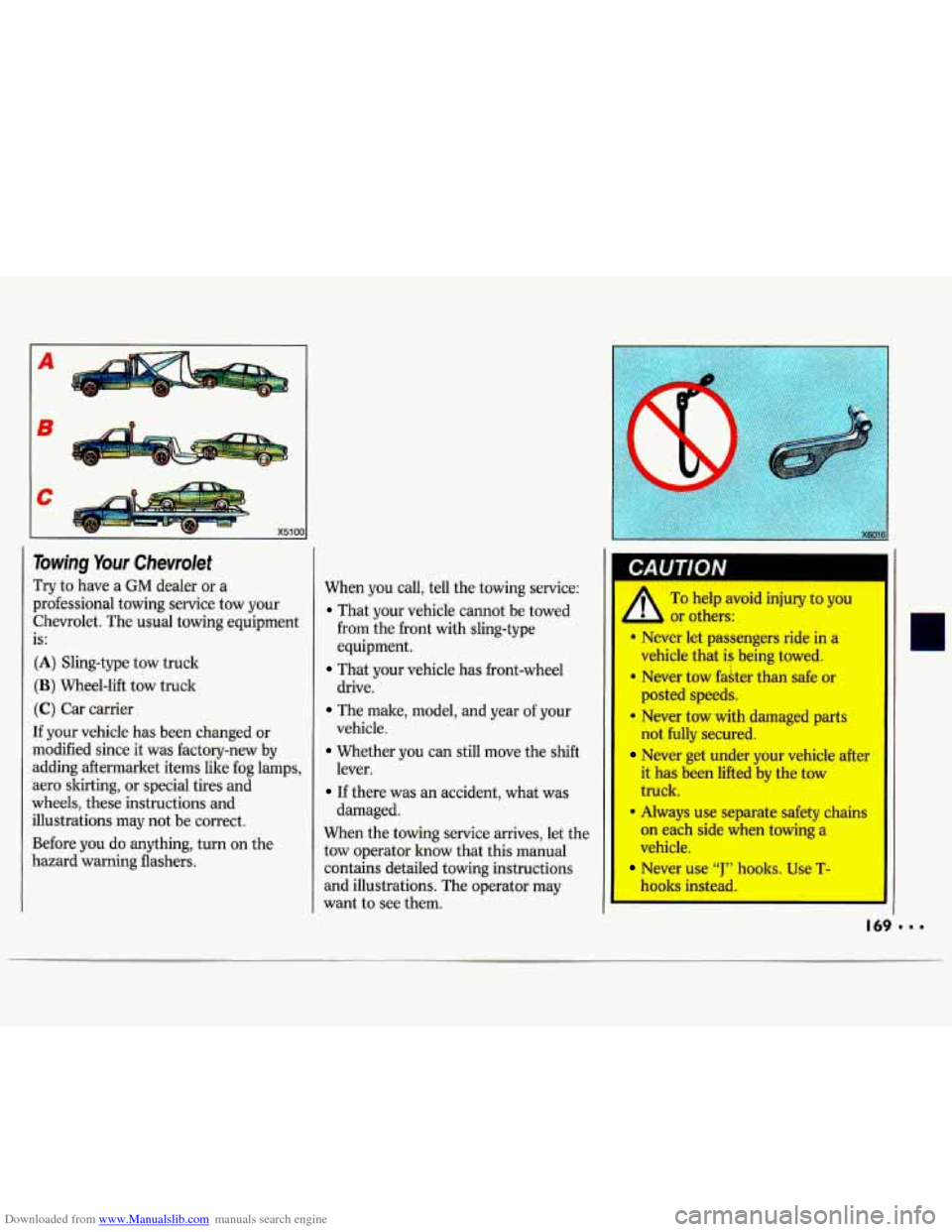
Downloaded from www.Manualslib.com manuals search engine A
B
Towing Your Chevrolet
Try to have a GM dealer or a
professional towing service tow your Chevrolet. The usual towing equipment
is:
(A) Sling-type tow truck
(B) Wheel-lift tow truck
(C) Car carrier
If your vehicle has been changed or
modified since it was factory-new by
adding aftermarket items like fog lamps,
aero slurting, or special tires and
wheels, these instructions and
illustrations may not be correct.
Before you do anything, turn on the
hazard warning flashers. When you call, tell
the towing service:
That your vehicle cannot be towed
from the front with sling-type
equipment.
drive.
vehicle. lever.
damaged.
That your vehicle has front-wheel
The male, model, and year of your
Whether you can still move the shift
If there was an accident, what was
When the towing service arrives, let the
tow operator know that this manual
contains detailed towing instructions
and illustrations. The operator may
want to see them.
PA I lTIn N
I
To help avoid injury to you
b or others:
Never kt paseengers ride in a
vehicle is being towed.
* Never tow €dter than safe or
posted speeds.
Never tow with damaged parts
not fully sawed.
Nwer get under your vehicle after
it has been lifted by the tow
truck,
on each side when towing a
vehicle.
Never use “J’’ hooks. Use T-
hooks instead.
* Always use separate safety chains
1